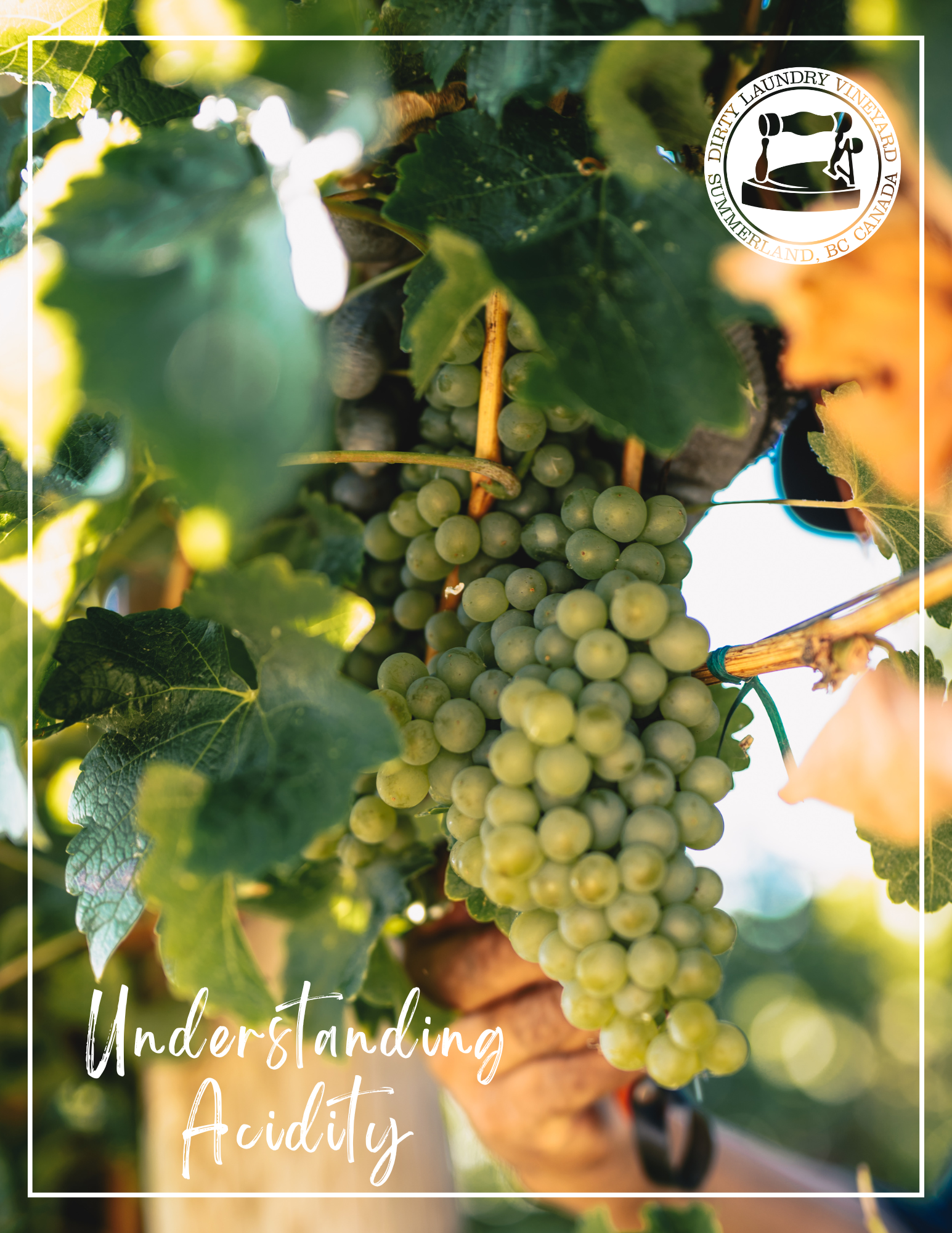Understanding Acidity: The Bright Backbone of Wine’s Flavour

When people talk about wine, they often mention words like “tannins,” “fruit-forward,” or “body,” but did you know that
acidity is one of the most fundamental and underappreciated elements that can make or break a wine? In fact, wine’s acidity plays a crucial role in creating balance and structure, ensuring it is refreshing and vibrant on the palate.
Let’s explore what wine acidity is, how it works, and why it matters.
What is Wine Acidity?
The total acidity of a wine affects its sharpness or sourness. When tasting wine, you can recognize acidity by the mouth-watering sensation it produces. A sip of high-acid wine will make your mouth water and leave a refreshing, crisp finish. You might also notice more citrusy or green fruit flavours. Lower-acid wines will feel richer and smoother and rounder on the palate, often with more dominant ripe fruit flavours.
Wine is a delicate balance of flavours, and acidity plays a vital role in that balance. A wine with the right acidity can cut through fatty or rich dishes, and complement both salty and sweet foods. Wine with
too little
acidity can taste heavy or excessively sweet, while one with
too much acidity might taste overly sharp. For this reason, winemakers strive to balance acidity with sweetness, alcohol, and tannins to create a harmonious wine.
Which Acids are Present in Wine?
Wine acidity refers primarily to the tartaric, malic, and citric acids in the wine. These acids give wine its refreshing edge, counteracting sweetness and enhancing flavours.
Tartaric Acid: This is the primary acid in wine and has a major influence on its taste. Tartaric acid is responsible for wine’s crisp, tart flavour and helps maintain its chemical stability. It’s also the main acid responsible for the “wine diamonds” or tartrate crystals that sometimes form in wine bottles.
Malic Acid: Found in green apples and grapes, malic acid gives wine a sharp, green apple-like taste. It’s more prominent in cooler climate wines where grapes don’t fully ripen. Winemakers often use malolactic fermentation to convert malic acid into the softer lactic acid, making the wine creamier and smoother, especially in red wines and some Chardonnays.
Citric Acid: Present in very small amounts, citric acid isn’t naturally prominent in grapes, but winemakers sometimes add it to increase acidity in a wine that needs a lift. Citric acid has a fresh, lemony flavour but is much less common than tartaric and malic acids.
Together, these acids balance the flavours in wine, complementing sweetness, bitterness, and tannins, and creating the refreshing quality we associate with good acidity.
Acidity and Wine Style
White wines tend to have higher acidity, which contributes to their bright, crisp character:
- Sauvignon Blanc: This wine is known for its high acidity, giving it a zesty, refreshing taste often reminiscent of citrus or green apple.
- Riesling: Another high-acid white, Riesling can range from bone-dry to sweet, with acidity providing balance to its fruity, sometimes honeyed flavours.
- Sparkling wines: Sparkling wines are usually made from high-acid grape varieties picked early to preserve acidity. High acidity is crucial for creating a crisp, refreshing character that balances the richness of the bubbles. The bubbles also help amplify the perception of acidity.
Red wines can vary, but some of the most refreshing reds (like
Pinot Noir) have notable acidity compared to bolder reds like
Cabernet Sauvignon. The acidity in red wines can balance the fruitiness and tannins, making it refreshing and lively on the palate. The acidity of Pinot Noir also makes it particularly food-friendly, as it can cut through rich dishes and balance flavours in lighter, delicate dishes like salmon, roasted chicken, and mushroom-based meals.
Rosé wines are known for their bright, refreshing acidity, which is one of their signature characteristics. This acidity gives rosé its crispness and balance, accentuating the wine's delicate fruit flavours like strawberry, raspberry, citrus, and watermelon. The level of acidity in rosé can vary depending on the grape varieties used, the climate where the grapes are grown, and the winemaking style.
How Does Climate Impact Wine Acidity?
Cooler climates produce grapes with higher acidity since the fruit doesn’t ripen as fully, retaining more of its natural tartness. Warmer regions allow grapes to ripen fully, reducing acidity and increasing sugar levels, which produces a fuller-bodied, fruitier profile.
The Okanagan Valley of BC has a unique climate with notable temperature variations from north to south, impacting wine acidity and style across its sub-regions.
The northern part of the valley is cooler and wetter, with longer, cooler growing seasons, preserving acidity. Wines from this region typically showcase bright, high acidity and are often crisp and fresh. Riesling, Pinot Gris, and Chardonnay are popular here, as well as Pinot Noir for red. These wines often exhibit green apple and citrus flavours with a lively, refreshing acidity.
The central valley is slightly warmer, but still cool enough to maintain acidity in many grape varieties, however the warmer climate can bring out a bit more ripeness and body, softening the acidity slightly. The balance between freshness and ripeness is well-pronounced here.
Chardonnay,
Pinot Noir, and
Merlot thrive here, with wines displaying a balance of acidity and ripeness.
The southern part of the valley, around Oliver and Osoyoos, is much warmer and drier, with a desert-like climate and high summer temperatures. This climate reduces acidity, as grapes ripen faster and develop more sugar, leading to fuller-bodied, richer wines. Red varietals like
Cabernet Sauvignon,
Syrah, and
Merlot dominate, producing bold wines with softer acidity.
The valley’s varied topography also creates microclimates at different elevations and along lakeshores, where cooler night temperatures preserve acidity. Even within a warmer region like southern Okanagan, wines from higher-elevation vineyards tend to have more balanced acidity.
Conclusion
Acidity is an essential component that shapes how a wine tastes and feels, contributing to a wine’s freshness, and food pairing potential. Whether you enjoy the zesty brightness of a Sauvignon Blanc or the balanced structure of a Pinot Noir, understanding acidity can enhance your appreciation of wine and help you make more informed choices.
Next time you sip a glass of wine, pay attention to that refreshing, mouth-watering sensation—it’s the acidity bringing everything into balance.

